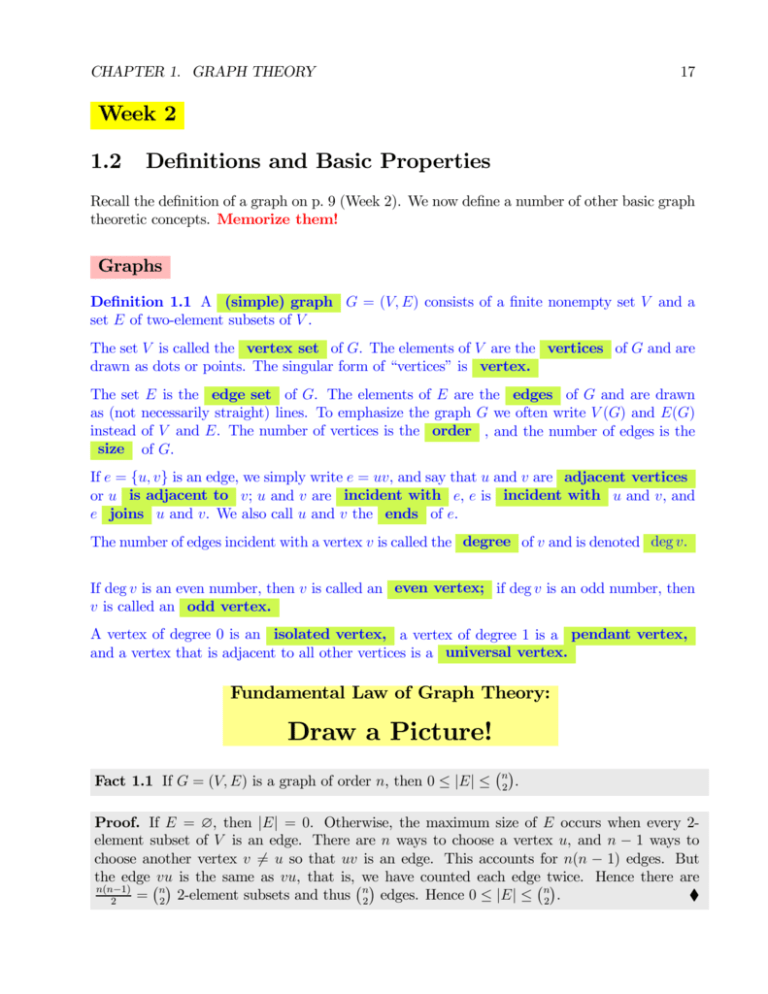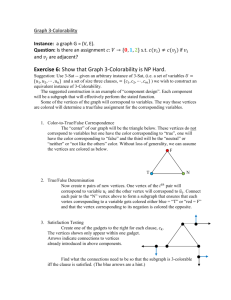Draw a Picture!
advertisement

CHAPTER 1. GRAPH THEORY
17
Week 2
1.2
Definitions and Basic Properties
Recall the definition of a graph on p. 9 (Week 2). We now define a number of other basic graph
theoretic concepts. Memorize them!
Graphs
Definition 1.1 A (simple) graph = ( ) consists of a finite nonempty set and a
set of two-element subsets of .
The set is called the vertex set of . The elements of are the vertices of and are
drawn as dots or points. The singular form of “vertices” is vertex.
The set is the edge set of . The elements of are the edges of and are drawn
as (not necessarily straight) lines. To emphasize the graph we often write () and ()
instead of and . The number of vertices is the order , and the number of edges is the
size of .
If = { } is an edge, we simply write = , and say that and are adjacent vertices
or is adjacent to ; and are incident with , is incident with and , and
joins and . We also call and the ends of .
The number of edges incident with a vertex is called the degree of and is denoted deg .
If deg is an even number, then is called an even vertex; if deg is an odd number, then
is called an odd vertex.
A vertex of degree 0 is an isolated vertex, a vertex of degree 1 is a pendant vertex,
and a vertex that is adjacent to all other vertices is a universal vertex.
Fundamental Law of Graph Theory:
Draw a Picture!
Fact 1.1 If = ( ) is a graph of order , then 0 ≤ || ≤
¡¢
.
2
Proof. If = ∅, then || = 0. Otherwise, the maximum size of occurs when every 2element subset of is an edge. There are ways to choose a vertex , and − 1 ways to
choose another vertex 6= so that is an edge. This accounts for ( − 1) edges. But
the edge ¡¢ is the same as , that is, ¡we
Hence there are
¢ have counted each edge¡twice.
¢
(−1)
= 2 2-element subsets and thus 2 edges. Hence 0 ≤ || ≤ 2 .
¨
2
CHAPTER 1. GRAPH THEORY
18
a
G
a
b
e
d
c
H
b
e
d
c
Figure 1.4: Graphs and with () = () = { }, () = { },
() = { }
Fact 1.2 Every graph of order at least two has at least two vertices of the same degree.
Proof. Suppose has order ≥ 2. Since 0 ≤ deg ≤ − 1 for any vertex of , there are
possibilities for the degrees of vertices of .
• Suppose deg = 0 for some ∈ . Then is not adjacent to any vertex of , which is
the same as saying that no vertex of is adjacent to . Then 0 ≤ deg ≤ − 2 for each
vertex of , so there are only − 1 possibilities for the degrees of vertices of .
• Suppose no vertex satisfies deg = 0. Then 1 ≤ deg ≤ − 1 for each vertex of ,
and again there are only − 1 possibilities for the degrees of vertices of .
Since has vertices, the pigeonhole principle implies that there are two vertices of the same
degree.
¨
Practice Questions: Do them NOW!
Exercises, p. 15: 1, 3, 9
Subgraphs
Memorize!
Definition 1.2 A graph is a subgraph of a graph if () ⊆ () and () ⊆ ().
If () = (), then is called a spanning subgraph of .
Note that must be a graph — it cannot have edges of if it doesn’t also have the ends of
the edges as vertices. The graphs and in Figure 1.5 are subgraphs of ; is a spanning
subgraph of and is not.
CHAPTER 1. GRAPH THEORY
19
a
a
g
b
g
e
G
c
f
c
f
e
d
g
b
H
b
c
f
d
F
d
Figure 1.5: A graph with spanning subgraph and nonspanning subgraph
K1
K2
K3
K4
Figure 1.6: The complete graphs 1 , 2 , 3 and 4
Notation The subgraph of = ( ) obtained by deleting a vertex is denoted by \{}
(in the textbook) or simply by − . The subgraph of obtained by deleting an edge is
denoted by \{} (in the textbook) or simply by − .
Complete Graphs
Definition 1.3 The graph of order in which every pair of vertices are adjacent, is called the
complete graph of order and is denoted .
The complete graph 3 is also called a triangle. Memorize!
As shown in Fact 1.1, has
Example
¡¢
2
edges. The graphs 1 , 2 , 3 and 4 are shown in Figure 1.6.
How many spanning subgraphs does have?
¡ ¢
• has 2 edges. Any spanning subgraph of also has vertices, and all we have to
decide is whether a given edge is to¡be
¢ in a spanning subgraph or not. Thus for each edge
there are two options, so has 2
2
= 2(−1)2 spanning subgraphs.
CHAPTER 1. GRAPH THEORY
20
K3,3
Figure 1.7: The complete bipartite graph 33
Bipartite Graphs
Definition 1.4 A graph = ( ) is called a bipartite graph if there exists a partition,
called a bipartition, {1 2 } of such that each edge in joins a vertex in 1 and a vertex
in 2 . The sets 1 and 2 are called the partite sets of .
If every vertex in 1 is adjacent to every vertex in 2 , then is called a complete bipartite
graph and is denoted , where |1 | = and |2 | = . Memorize!
Example
Form a graph as follows. Draw a circle in the plane. Draw an even number ≥ 4 vertices on
the (line of the) circle. The line segments formed are the edges of the graph. Label the vertices
in order, say counterclockwise, of their appearance on the circle with the integers 1 2 3 .
The odd labels form 1 and the even labels for 2 , and the only edges join vertices in 1 to
vertices in 2 . Hence is bipartite.
Question: What happens if you add an odd number of vertices?
The graph 33 is shown in Figure 1.7.
Practice Questions: Do them NOW!
Exercises, p. 15: 5, 6, 7, 15, 16
A Theorem by Euler Memorize!
Proposition 1.1 The sum of the degrees of the vertices of a graph is an even number, equal
to twice the number of edges. That is, for any graph = ( ),
X
deg = 2||
∈
Proof. Add the degrees of all the vertices. Each edge is counted twice — once at each end (or
twice at the same end if it is a loop, in the case of a pseudograph).
¥
CHAPTER 1. GRAPH THEORY
21
Examples
1. Each vertex of has degree − 1, because it is adjacent to each vertex other than itself.
Thus has ( − 1)2 edges — another proof of Fact 1.1, because any graph of order
is a spanning subgraph of .
2. Consider with bipartition (1 2 ), where |1 | = and |2 | = .PEach of the
vertices in 1 has degree and each vertex in 2 has degree , thus ∈1 ∪2 deg =
+ = 2, and so has size . Of course, one may also argue that the
edges incident with the vertices in 1 account for all the edges, and obtain |( )| =
more directly.
Corollary 1.1 Any graph has an even number of odd vertices. Memorize!
Proof. Let = { ∈ : deg is even} and = { ∈ : deg is odd}. By Proposition 1.1,
X
X
X
deg =
deg +
deg
(1.1)
2|| =
∈
∈
∈
P
Since
the
left
side
of
(1.1)
is
even,
the
right
side
is
even
too.
Since
∈ deg is even, so is
P
deg
.
Since
the
sum
of
odd
numbers
is
even
iff
there
is
an
even
number of summands,
∈
the result follows.
¥
Definition 1.5 Suppose 1 2 are the degrees of a graph , ordered so that 1 ≥ 2 ≥
· · · ≥ . Then 1 2 is called the degree sequence of . Memorize!
Examples
1. The degree sequence of the graph in Figure 1.5 is 4 4 3 3 2 2 2.
2. The degree sequence of 34 is 4 4 4 3 3 3 3.
3. No graph has degree sequence 7 6 5 4 3 2 1. Why not?
4. No graph has degree sequence 6 5 4 3 3 2 1 1. Why not?
Practice Questions: Do them NOW!
True/False, p. 14
Exercises, pp. 15—16: 12, 13, 14, 18, 20
CHAPTER 1. GRAPH THEORY
a
b
c
22
r
s
t
d
e
p
x
u
y
q
v
z
Figure 1.8: Three isomorphic graphs
1.3
Isomorphism
In this section we discuss what it means to say that “two graphs are essentially the same”.
Consider the graphs and in Figure 1.4. At a first glance they don’t look the same, but
can be redrawn to look like : consider the pentagon with no crossed edges and labels
, in this order. More formally, let be the function from () to () defined by
() = () = () = () = () =
Clearly, is a bijection from () to (). Moreover,
() () = ∈ () () () = ∈ () () () = ∈ ()
()() = ∈ () and ()() = ∈ ()
Thus also preserves adjacencies, that is, ∈ () if and only if () () ∈ ().
Definition 1.6 Two graphs and are isomorphic, written ∼
= , if there exists a
bijection (1 − 1 and onto function) : () → () such that for all ∈ (),
∈ () if and only if ()() ∈ ()
Such a function is called an isomorphism. Memorize!
Abusing notation somewhat, we also say that : → is an isomorphism.
Examples
1. The three graphs in Figure 1.8 are all isomorphic, and each is isomorphic to 23 .
2. Are the graphs and in Figure 1.9 isomorphic?
• Note that | ()| = | ()| = 6 and |()| = |()| = 9.
To show that ∼
= , we need to redraw to look like or to define an isomorphism
from to .
To show that À , we need to find a property of one graph that is not a property
of the other.
CHAPTER 1. GRAPH THEORY
23
1
1
6
2
4
2
5
H
G
6
5
3
4
3
Figure 1.9: Two nonisomorphic graphs
Note that {1 2 3} forms a triangle of , but for any choice of ∈ {1 2 3 4 5 6},
{ } does not form a triangle of .
Thus À .
The relation on the set of all graphs defined by ( ) ∈ if and only if and are
isomorphic, is an equivalence relation, and the equivalence classes are collections of graphs
which are “the same” in this sense. We frequently draw pictures of graphs without labelling
the vertices. These unlabelled graphs are understood to represent any of the possible graphs
obtained by giving names to the vertices.
In general, when the number of vertices is large, determining whether two graphs are isomorphic
is a very difficult problem.
Proposition 1.2 If and are isomorphic graphs, then they have the same
• order
• size
• number of triangles
• degree sequences.
The converse of this statement is not true.
Practice Questions
True/False, p. 20
Exercises, pp. 20—22: 1, 3, 4(b), 8(a).
CHAPTER 1. GRAPH THEORY
1.4
24
Eulerian Circuits
Walks, Trails, Paths, Circuits and Cycles
Memorize!
Definition 1.7 A walk (or 0 - walk) in a (simple) graph is a sequence 0 1 2 3
of vertices such that consecutive vertices are adjacent.
The length of a walk is the number of edges in the walk, one less than the number of vertices.
The length of the 0 - walk above is .
A trail is a walk in which no edge is repeated.
A path is a walk in which no vertex is repeated, thus no edge is repeated either. The graph
that consists of a path on vertices is denoted .
A - walk is open if 6= and closed if = .
A closed trail is also called a circuit, and a cycle is a circuit in which the only repeated
vertex is the first vertex, this being the same as the last vertex. The graph that consists of a
cycle on vertices is denoted . The cycle is even if is even, and odd if is odd.
Note
• Every path is a trail (to repeat an edge you must repeat one of its ends) and every trail
is a walk.
• There are walks that are not trails, and trails that are not paths.
• If ∈ (), then “” is a perfectly good - walk; it has length 0.
a
b
g
c
f
e
d
Figure 1.10: A graph with an - walk
CHAPTER 1. GRAPH THEORY
25
Examples
1. is an - walk in the graph in Figure 1.10.
2. is an - trail but not a path in the graph in Figure 1.10, while
and are - paths.
3. The graphs and in Figure 1.4 are both isomorphic to 5 .
Fact 1.3 If a graph has a - walk, then it has an - path.
Proof. Consider a shortest - walk = 0 1 −1 = in . If this walk is not a path,
then there are indices and with 1 ≤ ≤ such that = :
= 0 1 +1 +1 −1 =
| {z }
delete
But then the walk 0 1 +1 −1 is a shorter - walk in , a contradiction.
¨
We prove two more facts before discussing special types of trails, circuits and cycles.
Fact 1.4 If deg ≥ for each ∈ , then has a path of length .
Proof. Consider a longest path : 0 1 in . Note that has length . Since is a
longest path, 0 is not adjacent to any vertices in − {1 2 }, otherwise there exists a
longer path. Since deg 0 ≥ , 0 is adjacent to at least vertices in {1 2 }. Therefore
≥ , and so a longest path in has at least edges.
¨
Fact 1.5 If deg ≥ 2 for each ∈ , then has a cycle.
Proof. Let : 0 1 be a longest path in . By Fact 1.4, ≥ 2, and as in the proof
above, 0 is adjacent to at least one vertex on other than 1 . Then 0 1 0 is a
cycle of .
¨
Eulerian Trails and Circuits
Memorize!
Definition 1.8 An Euler or Eulerian trail in a graph or pseudograph is a trail that
uses every vertex in () and every edge in ().
An Euler or Eulerian circuit is a circuit that uses every vertex in () and every edge
in ().
CHAPTER 1. GRAPH THEORY
26
Example
For the graph in Figure 1.13, is a circuit and is an
Euler circuit.
Connected Graph, Eulerian Graph
Memorize!
Definition 1.9 A graph = ( ) is called connected if there exists a - path in for
all ∈ .
If is not connected, it is called disconnected. In this case the maximal connected subgraphs of are called the components of .
If is connected and has an Eulerian circuit, we call an Eulerian graph.
Usually graphs are drawn so that it is obvious whether they are connected or not. However,
one has to look more carefully to see that the graph in Figure 1.11 is disconnected: there is no
- path, for example. The graph has two components: the subgraphs induced by { } and
{ }, respectively.
Having defined connected graphs, we digress briefly to give a well-known and useful characterization of bipartite graphs.
Fact 1.6 A graph is bipartite iff it contains no odd cycles. Memorize!
Rather than proving this, we look at an algorithm that takes any graph and either finds the
partition or finds an odd cycle.
• It is not hard to see that if is bipartite, then all cycles have even length.
• Method for finding a partition of () when is bipartite:
For each component of ,
a
f
b
e
c
d
Figure 1.11: A disconnected graph
CHAPTER 1. GRAPH THEORY
•
27
pick any vertex ,
put into 1 ,
put all vertices adjacent to in 2 ,
put all vertices adjacent to a vertex in 2 in 1 , etc.
If during this procedure some vertex is put into both 1 and 2 , then there is an odd
cycle in . Otherwise, we find a bipartition of ().
¨
Example
2
start
1
3
4
6
5
7
8
1
2
3
4
7
5
8
6
Figure 1.12: Constructing a bipartition
Theorem 1.1 A graph is Eulerian iff it is connected and every vertex has even, positive degree.
Memorize!
b
G
c
a
d
f
e
Figure 1.13: An Eulerian graph
Theorem 1.2 A graph has an Eulerian trail between two different vertices and iff it is
connected and all vertices except and are even, while and are odd. Memorize!
Practice Questions
True/False, p. 27
Exercises, pp. 27—29: 1, 3(a), 4(a), 8(a), 10, 15, 22.









